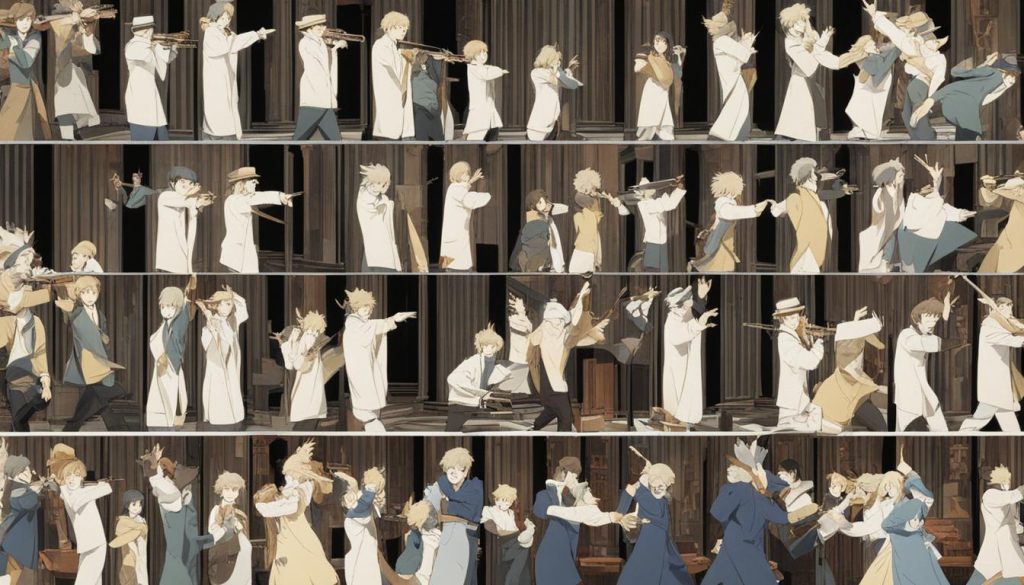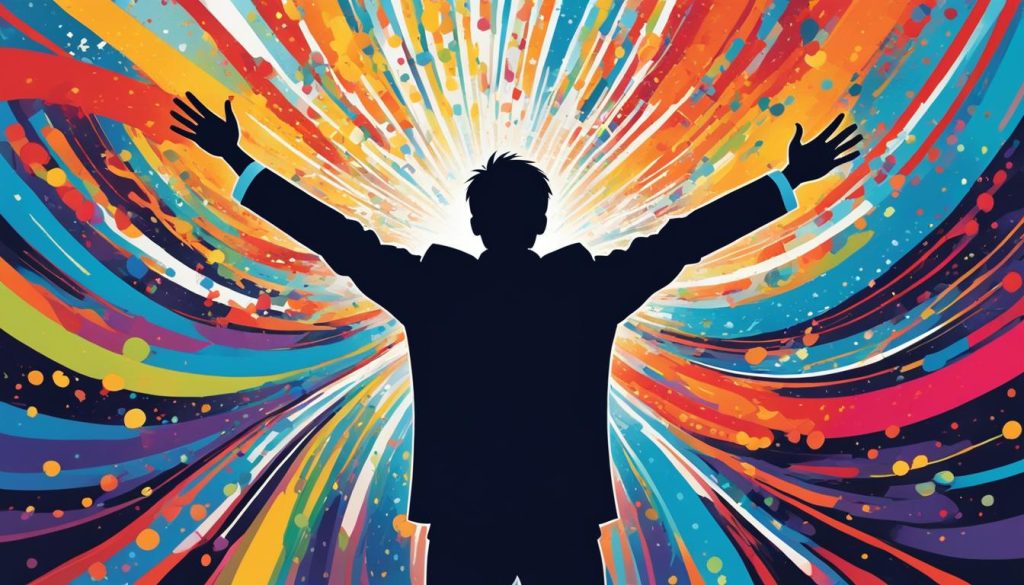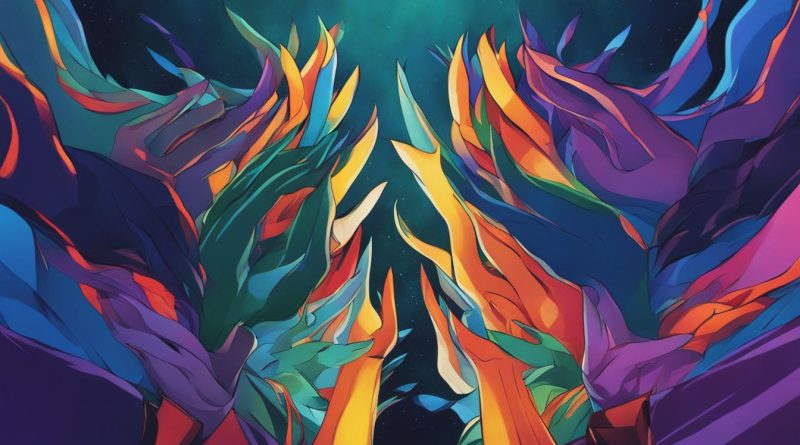Jazz Hands: The Art and History of a Gesture
Jazz hands, perhaps one of the most recognizable gestures in performing arts, has a rich history deeply intertwined with musical theater and dance. This iconic gesture, consisting of open hands with fingers splayed, has fascinated audiences for decades with its striking expressiveness and symbolic depth.
The roots of jazz hands can be traced back to the early days of jazz music and dance, where it served as a key element in many performances. Today, it remains a fundamental part of various genres, such as Broadway shows and musical theater, regularly captivating audiences with its artistic flair and emotional resonance.
Exploring the artistic and historical significance of jazz hands allows us to gain a deeper appreciation for this iconic gesture and its role in the world of performing arts.
Key Takeaways:
- Jazz hands is an iconic gesture in performing arts.
- It has roots in early jazz music and dance.
- Jazz hands is a fundamental aspect of various performance genres, such as Broadway and musical theater.
- It enhances choreography and captivates audiences through its symbolism and expressiveness.
- Performers and choreographers have made jazz hands their signature move.
The Origins of Jazz Hands
Jazz hands are one of the most iconic gestures associated with performing arts. However, very few people know about its origins. The jazz hands can be traced back to the early days of jazz music and dance. During that time, jazz musicians and dancers used the gesture to add emphasis to their performance. It was an extension of the dynamic movement of the jazz dance and a way to make the performer appear more welcoming and engaging to the audience.
As the popularity of jazz music grew, so did the popularity of the jazz hands gesture. It soon became a fundamental aspect of various performance genres, such as Broadway and musical theater. One of the earliest documented uses of jazz hands in these genres was in George M. Cohan’s musical Little Johnny Jones in 1904.

Jazz hands quickly became a staple of musical theater, particularly during the golden age of Broadway. Performers like Ethel Merman and Gwen Verdon were known for their dazzling dance moves and frequent use of jazz hands. To this day, the gesture remains a popular expression of artistic performance.
The Symbolism and Expressiveness of Jazz Hands
Jazz hands are more than just a rhythmic and energetic gesture; they hold a deep symbolism and expressiveness that captivates audiences. This iconic gesture has been used in various performance genres, from musical theater to modern dance.
Symbolism
Jazz hands have been associated with celebration, joy, and victory. They are often used to express excitement, enthusiasm, and triumph in performance. Jazz hands can also symbolize freedom and self-expression, as they represent an artistic movement that broke boundaries in the world of dance.
The symbolism of jazz hands has been used in various cultural contexts as well. In the LGBTQ+ community, jazz hands have become a symbol of acceptance, inclusion, and pride. They represent a way of celebrating diversity and expressing oneself without fear of judgment.
| Name | Genre | Notable Use of Jazz Hands |
|---|---|---|
| Bob Fosse | Musical Theater | Choreographed iconic jazz hands sequence in “All That Jazz” |
| Lady Gaga | Pop Music | Popularized jazz hands in her performance of “Bad Romance” |
| Michael Jackson | Pop Music | Incorporated jazz hands into his signature moonwalk move |
Expressiveness
Jazz hands are not only symbolic but also highly expressive. They can be used to convey a range of emotions, from excitement and happiness to sadness and despair. In choreography, jazz hands can enhance the overall aesthetic and add a level of complexity to the movement.
The expressiveness of jazz hands can be seen in the performances of famous artists. Bob Fosse, a renowned choreographer, incorporated jazz hands into his signature style, using them to emphasize the sharpness and clarity of his movements. Lady Gaga, another notable performer, popularized jazz hands in her music videos and live performances, using them to convey a sense of theatricality and drama.
“Jazz hands are an extension of my personality, my sense of self. They are a way of expressing my artistic vision and creativity.” – Lady Gaga
Overall, jazz hands hold a significant place in the world of performing arts, representing the artistry and history of a gesture that continues to captivate audiences. From the symbolism of celebration and freedom to its expressive qualities in choreography, jazz hands remain a powerful and iconic gesture that will always have a place in the world of performance.

Conclusion
Throughout the article, the significance of jazz hands in the world of performing arts has been explored. From its origins in jazz music and dance to its use in various performance genres such as Broadway and musical theatre, jazz hands have become an iconic gesture that continues to captivate audiences.
Not only is jazz hands a visually appealing gesture, but it also carries great symbolism and expressiveness. Its ability to convey emotions and enhance choreography has made it a popular choice among performers and choreographers alike.
In conclusion, the artistry and history behind jazz hands make it an enduring expression of artistic performance. As it continues to be embraced by performers and audiences around the world, it is clear that jazz hands will remain an essential aspect of the performing arts for years to come.
FAQ
What are jazz hands?
Jazz hands are a gesture commonly used in the performing arts, characterized by extended and spread fingers with palms facing forward. It is often accompanied by a slight shaking or vibrato movement of the hands.
Where did jazz hands originate?
Jazz hands originated in the early days of jazz music and dance, particularly in African American communities. This expressive gesture became intertwined with various performance genres, including Broadway and musical theater.
What is the symbolism behind jazz hands?
Jazz hands are symbolic of energy, enthusiasm, and showmanship. They are often used to visually enhance choreography, convey emotions, and captivate audiences. The gesture represents a vibrant expression of artistic performance.
Who are some notable performers known for their use of jazz hands?
Several performers and choreographers have embraced jazz hands as their signature move. Notable examples include Bob Fosse, a renowned choreographer known for his distinct style and use of jazz hands in Broadway productions, and Liza Minnelli, an iconic singer and actress who frequently incorporates jazz hands into her performances.
Can anyone learn how to do jazz hands?
Yes, anyone can learn how to do jazz hands! While it may take some practice to perfect the technique and coordination, with proper guidance and dedication, anyone can master this iconic gesture and incorporate it into their performances or dance routines.
Are jazz hands exclusive to a specific type of performance?
Jazz hands are not exclusive to a specific type of performance. While they are commonly associated with musical theater and broader theatrical productions, jazz hands can be incorporated into various forms of dance, including jazz, contemporary, and even social dancing.
How do jazz hands enhance a performance?
Jazz hands enhance a performance by adding visual flair and expressiveness. They draw attention to the performer’s hands and movements, creating a dynamic and captivating presence on stage. Jazz hands can convey excitement, joy, and intensity, amplifying the overall impact of a performance.
Are jazz hands still relevant in modern-day performances?
Absolutely! Jazz hands remain relevant and continue to be utilized in modern-day performances across different genres, including theater, dance, and even pop culture. This iconic gesture has stood the test of time and is celebrated as a powerful expression of artistic flair and showmanship.
